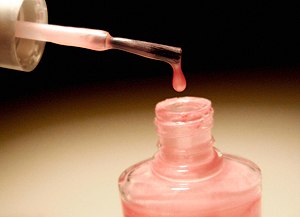Inhalant abuse
| Inhalant abuse | |
|---|---|
 |
|
| Common household products such as nail polish contain solvents that can be concentrated and inhaled, in a manner not intended by the manufacturer, to produce intoxication. Misuse of products in this fashion can be harmful or fatal. | |
| Classification and external resources | |
| Specialty | emergency medicine |
| ICD-10 | F18.1, T52, T53 |
| ICD-9-CM | 981, 982 |
| eMedicine | article/1174630 |
Inhalants are a broad range of household and industrial chemicals whose volatile vapors or gases are concentrated and breathed in via the nose or mouth to produce intoxication, in a manner not intended by the manufacturer. They are inhaled at room temperature through volatilization (in the case of gasoline or acetone) or from a pressurized container (e.g., nitrous oxide or butane), and do not include drugs that are sniffed after burning or heating. For example, amyl nitrite (poppers), nitrous oxide and toluene – the solvent used in contact cement and model airplane glue – are considered inhalants, but smoking tobacco, cannabis, and crack are not, even though these drugs are inhaled (as smoke).
While a small number of inhalants are prescribed by medical professionals and used for medical purposes, as in the case of nitrous oxide (an anxiolytic and pain relief agent prescribed by dentists), this article focuses on inhalant use of household and industrial propellants, glues, fuels and other products in a manner not intended by the manufacturer, to produce intoxication or other psychoactive effects. These products are used as recreational drugs for their intoxicating effect. According to a 1995 report by the National Institute on Drug Abuse, the most serious inhalant abuse occurs among homeless children and teens who "...live on the streets completely without family ties." Inhalants are the only substance which is used more by younger teens than by older teens.Inhalant users inhale vapor or aerosol propellant gases using plastic bags held over the mouth or by breathing from a solvent-soaked rag or an open container. The practices are known colloquially as "sniffing", "huffing" or "bagging".
...
Wikipedia
